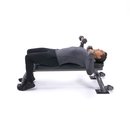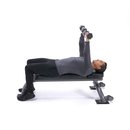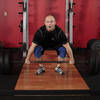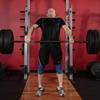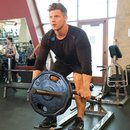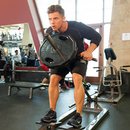The program I use emphasizes and creates the following: strength, flexibility, power and speed.
Sprinting is a difficult combination of aggression, relaxation, technique and efficiency. The 100 meters is sometimes labeled as the easiest most complicated event in sport! And contrasting bodybuilding, gaining too much size can become a negative. Generally speaking world-class sprinters are not that large, anywhere from 155-180lbs. In fact, what's interesting is that some sprinters do not lift weights at all! But for those of us who aren't as genetically gifted, the ultimate goal is having incredible strength-to-weight ratios, lean body mass and a well-developed CNS (central nervous system) for fast reaction and the ability to explode on command.
Unfortunately having too much bulk, especially throughout your chest and shoulders, can significantly decrease your ability to relax and control what your body is doing at high speeds. Relaxation is important to maintain this top-end speed; it's by far been one of the hardest things for me to overcome. Throughout my high school career, I would spend all year lifting weights, mainly upper body, and then just run in the actual track meets. My idea of practice was getting in some abs, heavy curls and bench press. So I literally competed myself into shape. College was a different story; I learned real quick that even though a big chest looks good, it would NOT help you sprint to your fullest potential. I ended up shedding the chest and grew some legs.
Training Seasons
Depending on the person or specific event, a track and field "season" can wind up being very long. It's anywhere from 8-11 months depending on one's indoor and outdoor goals. There was a point in my career where I had been both training and competing for 20 consecutive months! It was a grueling task that predictably concluded in a major injury...a pectoralis major tear ripping off the right shoulder bone. Surgery and four screws later, I was successfully on my way to recovery. The surgeon and staff at the Olympic Training Center were absolutely amazing throughout my recovery process. At three weeks post-op, they had me five weeks ahead of schedule.
A "season" is broken up into three basic cycles: Fall/Pre-season, indoor competition, and outdoor competition. The fall, usually beginning late September early October, is where I am currently at and will continue to be at until the early parts of January. Indoor competition ranges from January through March. And outdoor schedules can range from March all the way through September.
Each cycle of the season is broken down into many different parts, for many different reasons. Throughout the season I will continue to explain my training program, writing specifically about what is going on as it happens. Doing so will avoid confusion and prevent us from getting ahead of ourselves.
Due to my pectoral injury last April, I spent the past six months rehabbing, gaining back strength, and working on my sprint mechanics. In all areas I'm ahead of the game compared to where I was at this time last year. For the exception of bench press, it's safe to say I'm at 100%. If you share a similar situation, it's =important at this time to become as healthy as possible in EVERY aspect. All of the "little things" need to be addressed: injuries, nutrition, sleep, social life and being in a positive environment, to name a few.
At this point in Fall Training I'm getting in enough shape to really get in shape. Focusing mainly on base training, increasingly heavy Olympic lifts, foot strength and sprint mechanics ... not to mention a ton of core strength for the hips, abs and lower back. Although the beach muscles aren't left out, the main goal at this time is to become as strong as possible and become the best athlete possible. Basically what's going on is I'm tearing my body down, way down. The obvious point of this is to build it back up for the physical and mental rigors of the season that lay ahead. Along with this, the proper rest is added in to allow the body to rebound and overcompensate the damages put onto it. Recovery is very important; I will address this later on in detail.
Training Three Times A Day
Currently the program involves training three times a day on Monday, Tuesday, Thursday and Friday; Saturday is reserved for a single specific workout. The time frame I personally use is the following:
- 1st Workout - 10 a.m. ... 20-45 minute active warm-up, max velocity sprint mechanics, plyometrics/bounding, and a cool-down of 10-15 minutes.
- 2nd Workout - 3 p.m. ... 20 minute warm up, main workout/general conditioning, 10-15 minute cool down.
- 3rd Workout - 5 p.m. ... Weights
- ... Saturday workout is typically late morning or early afternoon.
Six Phases
As the season progresses, the workout program gets increasingly more technical, specific and fine-tuned. This is due to the nature of track and field events. The 100-meter dash is broken down into these six phases:
- The start... 15 meters.
- Acceleration phase... 15-20 meters.
- Transition phase... 20-40 meters.
- Maximum Velocity 1... 40-60 meters.
- Maximum Velocity 2... 60-80 meters.
- Speed Maintenance... 80-100 meters.
Each phase needs to be addressed in order to maximize your success, and ideally, each phase will run together smoothly. In time and with a lot of practice, this will happen. I've been running the 100-meter dash for nine years, and I still have a lot to learn and work on. Patience is important in developing yourself in this event. The problem is that sprinters tend to want things NOW!
Full Warm-Up
To get into detail with the current workouts, I'll begin by explaining my warm-up that takes around 20-25 minutes. It's called a "Dynamic Movement Circuit" and it's done using only 30 meters:
Alternate buildup going down with a skip coming back, (4x30m).
- Skipping forward with arms swinging across body.
- Skipping forward with alternating arm swings up/down.
- Skipping backward with heel raises.
- Skipping backward with high knees.
30m build up.
- Side skipping with arm circles ... down and back.
- Cariocas emphasizing fast thigh drive to the ground.
- Rear kicks.
- Running backward emphasizing a long reach.
30m build up.
- Skipping high knees up and out.
- Skipping high knees up and out going backward.
- Skipping lateral straight leg.
- Skipping lateral straight leg backward.
- Skipping with spins.
30m build up.
- Jumping jacks moving forward to 15m, then a jog for the next 15m.
- Jumping jacks with high knees clapping under knees.
- Straight leg bounding.
- Toe touches.
The next section of the warm-up is done with 15 meters
- Walking on toes.
- Walking on heels.
- Side stepping toes then heels ... left and right.
- Walking pulling knee to chest.
- Walking opposites ... elbow to knee.
- Walking swinging leg up and touching toes.
- Walking quad/glute holds.
- Cross over jumping jacks.
The following lunges are done with 7 repetitions on each leg
- Static lunges (alternating).
- Backward lunges.
- Front lunge with opposite elbow reaching to leg extended.
- Diagonal lunge with opposite elbow reaching to leg extended.
- Leg swings front to back.
- Leg swings side to side.
By now you should be warmed up, if not, feel free to add any additional exercises or stretching to suit your specific needs.
After properly warmed up, my first workout spends a considerable amount of time, anywhere from 30 minutes to an hour of work on maximum velocity sprint mechanics and/or plyometrics.
The idea of sprint drills is to rewire the CNS and neuromuscular system to operate faster and more effectively for the actual race. Doing these confuses the body's natural/normal tendencies with the speed and aggression actually needed to run at a World Class level. This is along with teaching you how to run correctly while applying the most amount of force possible.
Our goal is to improve my running technique so each leg cycle decreases by .01 seconds, I take anywhere from 46-50 strides in a 100 meter race. Simple math will tell you that if performed, I will eventually take almost half a second off my 100-meter time. Best case scenario says if done, I will be looking to hit the 9.6 range ... the current World Record is 9.78.
The First Workout Of The Day: Sprint and Plyometric Drills
The drills seem simple, but don't let that fool you into thinking they can be done passively or sloppy. If done aggressively and correctly, they can become quite exhausting. The main focus is on correct body posture, correct execution and fast ground-to-ground time. The drills are as follows:
- Ankling (toe up - heel up - step over opposite ankle). Heel raises (toe up - heel up - heel to hamstring) ... NOT butt kicks. Alternating L&R fast leg cycles. Double cycles, LL&RR. Continuous R cycles.* Continuous L cycles.
Each drill is done for 30 meters, 2-4 times on each leg with around 60-90 seconds rest in-between.
Plyometrics and bounds are also done during the first workout. Usually I do these on the opposite days of sprint drills; sometimes when I'm feeling really good I include everything together. The idea behind the plyo's and bounds is to get your body use to exploding and becoming extremely powerful at the point in which your foot/feet makes contact to the ground. That's the name of the game in the 100 meters. People with bad shins or ankles may have a hard time doing some of these exercises so be careful! I personally had shin splints for a number of years and I know how excruciating they can be. The following is the list of plyo's and bounds that I'm currently doing:
- Straight leg bounding.
- Alternating single leg bounds.
- "Skip-bounds" for height.
- "Skip-bounds" for distance.
- 42in. box jumps 4x5.
- Standing long jump for distance.
Except for the box jumps, each exercise is done three times.
After the first session it's important to do a good cool down. I spend 10-15 minutes stretching out and even doing some of the same things used in my warm-up. I personally like to go through a quick and light lunge series to really stretch everything out. Also be sure and ice any nagging injuries, and consume some protein within a few minutes of your workout. These things are very important in staying healthy and replenishing your body. Remember ... TAKE CARE OF THE LITTLE THINGS!
The Second Workout Of The Day: General Conditioning
The second workout of the day is where the greater part of my general conditioning is done. Like I said, this is the pre-season and what I'm doing is getting into shape to really get into shape. Even though the workouts at this time are not that ballistic, it's important to get another quality warm-up in. And of course a good cool down with a lot of stretching after the workout.
Throughout the weeks to come, the workouts change, but the general principle is the same. Workout atmosphere depends on where you are in the World. The great thing about San Diego is that it's almost always perfect weather here. I do the majority of the work barefoot in grass or sand! This helps build my feet and ankle strength. The following is an outline of my workouts performed throughout the week:
Monday: Flying 30's barefooted in the grass, (3 sets of 3) ... 2-3 minutes rest in-between each rep, and around 10 minutes in-between each set. At this point in time, these aren't that fast, mainly working on form and technique learned from the first session.
After the 30's, take a 10-minute rest and then I perform 5-7 "Power Hills." This is sprinting at around 80% up a hill that is around a 10-degree incline. The hill I use is close to 100 meters, be creative and use what's available to you. The purpose of these is to really work on your drive phase, power and sprinting form/technique. Typically I wait around 4-5 minutes in-between each one. Have fun!
When you're done be sure to cool down again and take in plenty of fluids.
Tuesday: No running done today, but after the workout you'll wish you wouldn't have found this article. Again, warm-up enough to where you're getting a good sweat, even though you're not running you're about to put your body through some pain.
The first thing you'll do is standing-in-place-running-arm swings. Sound simple enough? I thought so! You will perform these with dumbbells, anywhere from 5lbs to 25lbs depending on gender and strength... DON'T cheat yourself. I use 20lbs and it's not easy! I do this 10 times, 60 seconds on with 60 seconds off. The first 40-45 seconds is at a brisk pace, the last 15-20 seconds is all out sprinting of the arms. Be sure to pump your arms without recruiting all of your major muscles, try staying up tall using good technique. Make sure you get FULL range of motion.
The final exercise is what we call "Bulgarian Dips." This is possibly one of the most painful exercises I have ever performed. Each leg is used twice, for a series of 2-minute holds and gradual movements ... and the entire exercise is performed holding onto dumbbells at your side. This exercise is somewhat difficult to explain, but I'll do my best!
Using the single leg squat positions have your back foot on a chair, and your front foot extended out in front of you. Begin by taking 30 seconds to GRADUALLY go down into a parallel position, and then hold for another 30 seconds. At 1 minute, begin slowly rising for 30 seconds until you're half way up, hold for 15 seconds, then spend the final 15 seconds finishing until your front leg is locked out and you're standing again. Now do that to each leg twice, never taking more than 2 minutes rest in-between each set.
It's important keep you're back tall and never let your knees touch the ground.
Also, use a challenging dumbbell weight ... I use 20 lbs.
Wednesday: Rest and Recovery.
Thursday: Today I attack the cardio system with a great aerobic workout. Again, perform a good warm-up; make sure everything is working and loose. The workout won't take that long but it's going to definitely wear you out.
It's simple; find sand, whether it's on a beach or your local long jump pit. Make sure the sand you use isn't packed and hard. The deeper and softer the better. What you're performing is in-place running, focusing on high knees and aggressive arm swings.
The workout is performed like the in place weighted arm swings ... 10 sets of 60 seconds on with 60 seconds off. The first 40-45 seconds is very brisk, with the last 15-20 seconds being all out sprinting in place.
Cool down and go lift weights!
Friday: Today's workout is the same as Monday's, minus the flying 30's.
Anywhere from 5-8 "Power Hills," with rest depending on what you want to accomplish. Personally, I take plenty of rest in-between each sprint to make certain my power and sprint mechanics stay as sharp as possible throughout the entire workout.
For those of you want more cardio, run them continuously adding in a jog to the bottom of the hill. Though after a couple, you'll begin sacrificing your power output and possibly your ability to sprint up with crisp technique.
Cool down.
Saturday: Today's workout is used for active recovery.
After a week of hard training your body needs to rest and repair the damages you inflict upon it. These activities help restore neural fatigue, your body's physiological state and even emotional restoration.
There are many different ways to actively rest your body: light jogging, walking, swimming, cycling, etc. Even getting a massage would be an excellent idea today.
What I choose to do is ocean swimming, snorkeling or just taking a few laps in a pool. The best part about being in the ocean is the chilly water combined with the waves "massaging" your body.
Rest is necessary, as my coach says,"Rest is not a four letter word!" People sometimes see it as a bad thing, but without rest your body never has time to profit from all of the hard work that you put in.
Different people recover in different ways. No one is exactly the same; one workout may be beneficial for one person, yet insufficient or harmful to the next. For some people, working out less is actually better for them. The more a particular person is stressed either physically or emotionally, the more they need to focus on their recovery process.
Sleep, nutrition, and water intake are the obvious ways to help, but are frequently neglected. It's important to keep an eye on all these things in order to make the most out of your efforts.
The Third Workout Of The Day: The Weight Room.
The last session of the day is entirely weight room oriented! Like the track workouts, what I'm doing in the weight room is base/strength training. All Olympic lifts are obviously done emphasizing the proper technique, absolute quickness and power. As the year progresses, so will the weight being used. Sets and reps will also change to not only keep things mixed up, but to allow my body to peak for competitions.
Monday and Thursday focus on lower body; Tuesday and Friday focus on the upper body. After lifting, I finish up with some kind of ab work. I like to use a lot of the basics like crunches, weighted decline board sit-ups, and hanging knee-ups/leg raises. But you can do whatever you need to do for the best results.
The following is the list of exercises, sets and reps that I'm currently performing:

BodyFit
$6.99/month- 2,500+ expert-created single workouts
- 3,500+ how-to exercise videos
- Detailed workout instruction
- Step-by-step workout tips
- Training at gym or at home
- Access to Workout Plans
- Access to Bodyfit App
- Store Discounts
Already have a Bodybuilding.com account with BodyFit? Sign In

What comes with BodyFit?

- Instructional Videos
Don't risk doing a workout improperly! Avoid injury and keep your form in check with in-depth instructional videos.

- How-to Images
View our enormous library of workout photos and see exactly how each exercise should be done before you give it a shot.

- Step-by-Step Instructions
Quickly read through our step-by-step directions to ensure you're doing each workout correctly the first time, every time.

BodyFit
$6.99/month- 2,500+ expert-created single workouts
- 3,500+ how-to exercise videos
- Detailed workout instruction
- Step-by-step workout tips
- Training at gym or at home
- Access to Workout Plans
- Access to Bodyfit App
- Store Discounts
Already have a Bodybuilding.com account with BodyFit? Sign In

What comes with BodyFit?

- Instructional Videos
Don't risk doing a workout improperly! Avoid injury and keep your form in check with in-depth instructional videos.

- How-to Images
View our enormous library of workout photos and see exactly how each exercise should be done before you give it a shot.

- Step-by-Step Instructions
Quickly read through our step-by-step directions to ensure you're doing each workout correctly the first time, every time.
Wednesday: Rest and Recovery

BodyFit
$6.99/month- 2,500+ expert-created single workouts
- 3,500+ how-to exercise videos
- Detailed workout instruction
- Step-by-step workout tips
- Training at gym or at home
- Access to Workout Plans
- Access to Bodyfit App
- Store Discounts
Already have a Bodybuilding.com account with BodyFit? Sign In

What comes with BodyFit?

- Instructional Videos
Don't risk doing a workout improperly! Avoid injury and keep your form in check with in-depth instructional videos.

- How-to Images
View our enormous library of workout photos and see exactly how each exercise should be done before you give it a shot.

- Step-by-Step Instructions
Quickly read through our step-by-step directions to ensure you're doing each workout correctly the first time, every time.

BodyFit
$6.99/month- 2,500+ expert-created single workouts
- 3,500+ how-to exercise videos
- Detailed workout instruction
- Step-by-step workout tips
- Training at gym or at home
- Access to Workout Plans
- Access to Bodyfit App
- Store Discounts
Already have a Bodybuilding.com account with BodyFit? Sign In

What comes with BodyFit?

- Instructional Videos
Don't risk doing a workout improperly! Avoid injury and keep your form in check with in-depth instructional videos.

- How-to Images
View our enormous library of workout photos and see exactly how each exercise should be done before you give it a shot.

- Step-by-Step Instructions
Quickly read through our step-by-step directions to ensure you're doing each workout correctly the first time, every time.
Saturday: Active Recovery
Sunday: Rest





